(DE) Das Gleichgewicht erfordert einen instabilen Boden. Um ein Gleichgewicht zu finden, muss zuvor ein Ungleichgewicht bestehen. Bei der Suche nach dem Gleichgewicht gehen wir Kompromisse ein. Work-Life-Balance. Wir setzen uns Ziele, wie wir das Unkontrollierbare kontrollieren können. Detox. Was ist, wenn wir das Gleichgewicht nicht finden, es vermissen? Es wiederentdecken. Selfcare. Was ist, wenn wir durch Zufall plötzlich das perfekte Gleichgewicht finden?
Die Arbeit von Felice Berny-Tarente beschäftigt sich mit der Balance von Binaritäten. Sie befasst sich mit dem Ausdruck von geschlechterspezifischen Normen und deren Aufbruch. Mit ihrer Arbeit «Puff Puff Man» entwirft Berny-Tarente eine Art muskulöse und trotzdem weiche Jacke, welche sowohl mit der Materialität und Oberfläche spielt, aber auch gesellschaftlich etablierte Bilder aufgreift. Ups, mal wieder 4 Stunden Bildschirmzeit diese Woche. «Donna und Harry» sind Objekte aus Silikon und Kunsthaar von Noah Ismael Wyss. Diese Arbeit erforscht nicht nur die physische Verschmelzung von Menschen und Technik, sondern wirft auch Fragen zur Beziehung von Mensch und Gerät auf. Abhängigkeiten werden sichtbar und die Vermenschlichung der immer intelligenter werdenden Supercomputer. Weil die drei «Tabourets» allein auf zwei Beinen nicht stehen können, lehnen sie verteilt im Raum an verschiedenen Wänden. Standhalten ist manchmal ein Balanceakt, Stabilität ein Luxusgut. Alexandra Galian versteht konstante Instabilität und einen bewegten Blick auf ihr tägliches Umfeld als wichtige Basis ihres meist malerischen Schaffens.
Schlupflöcher zu finden, wenn man nicht in sich selbst hineinhören möchte, ist die einfachste Sache der Welt. Es gibt immer eine Ursache ausserhalb und es erfordert viel Mut, die eigenen Fehler zu erkennen und Verantwortung zu übernehmen. Und doch ist es der einzige Weg, um voranzukommen. Wenn das Leben eine Reise ist, dann ist es eine Reise, die nur bergauf geht. So beschreibt Alexei Monney seine Installation. Die grossformatigen Malereien «1+1=1» von Niels Hung nehmen Bezug auf die Räumlichkeiten der Schreinerei, enthalten in sich jedoch auch eigene Dimensionen. Sie können sowohl als reduzierte Darstellung eines Raums und einer Umgebung verstanden werden, wie auch als direkter Eingriff in den Raum. Horizontalen und Vertikalen sind ein zentrales Element in der Videoarbeit «T-Pose» von Sarafina McLeod. Die T-Pose ist ein Weg sich mit der Umwelt zu Verbinden. Es geht dabei um eine Aktivierung des Brustkorbbereichs und hat eine offene und energetische Wirkung.
Die Performance von Teo Petruzzi (die am Sonntag, 13.03. stattfindet) bezieht sich auf die Tradition des "Talerschwingens", die aus dem Appenzellerland stammende Tradition wird noch heute praktiziert. Die Verbindung zwischen Schweizer Tradition und Geld, die im Talerschwingen besteht, soll auf die Verflechtung von nationalistischen und kapitalistischen Schemen aufmerksam machen, die in der Schweiz besonders weit fortgeschritten ist.
I don’t want to live in a world without Glamour von Florent Bonzon lotet Grenzen zwischen Realität und Fiktion aus. Es stellt sich unweigerlich die Frage, wie sehr die Gesellschaft Kontrollverluste zu verzeichnen hat, wo wir Traditionen noch ernst nehmen und wo uns die digitale Welt längst in ihre glamourösen Welten verführt hat. Betrachtet man «High Shelf» von Zeno Germinale, schaut man hinauf. Es ist ein Zusammenspiel von allen Einzelteilen in Zenos Arbeit, die einen ausbalancierten Stand ermöglichen. Die Höhenunterschiede ergeben eine Spannung von Machtverhältnissen, welche auch auf unsere Gesellschaft appliziert werden könnten. Der Titel «high shelf» wirft die Frage des Zugriffs und der Zugänglichkeit auf bestehende Strukturen auf. Die Projektion «YOU ARE HERE» von Nadine Kunz thematisiert wie auch die Arbeit von Noah Ismael Wyss eine Verschmelzung bzw. einen Balanceakt zwischen Innen und Aussen. Textbasiert werden hier Zonen der Wahrnehmung erforscht und nach dem Ich, dem Du und dem Dazwischen gefragt. Ist der Prozess des Gleichgewichts etwas, das wir tun, oder etwas oder etwas, das einfach passiert?
(EN) Balancing requires an unstable ground. To find a balance implies a previous imbalance. In the process of seeking balance, we enter compromises. Work-life-balance. We set goals for ourselves, on how to control the uncontrollable. Detox. What if we don't find the balance, miss it? Rediscover it. Selfcare. What if we suddenly find the perfect balance by chance? This group exhibition shows through 10 positions of 10 different artists, a various range of perspectives on what the process of finding balance can possible be. Every artistic position deepen it self with the subject of balance in a own way. Trough the place and the setting the single works get in connection to eachother.
Hanging on the wall, Felice Berny-Tarente's work deals with the balance of binaries. It deals with the expression of gender norms and their disruption. With her work "Puff Puff Man," Felice designs a kind of muscular jacket that references both materiality and surface, but also addresses socially established images. Oops, another 4 hours of screen time this week. "Donna and Harry" are sculptures made of silicone and synthetic hair by Noah Ismael Wyss. This work not only explores the physical merging of humans and technology, but also raises questions about the relationship between humans and devices. Dependencies become visible and the humanization of the increasingly intelligent supercomputers.
Because the three "Tabourets" cannot stand on two legs alone, they are distributed around the room leaning against various walls. Standing firm is sometimes a balancing act, stability a luxury item. Alex G understands constant instability and a moving view of her daily environment as an important basis of her mostly painterly work. Finding loopholes when you don't want to look inside yourself is the easiest thing in the world. There is always a cause outside and it takes a lot of courage to recognize your own mistakes and take responsibility. And yet it is the only way to move forward. If life is a journey, then it is a journey that only goes uphill. This is how Alexei Monney describes his installation. The large-format paintings «1+1=1» by Nils Hung refer to the premises of the carpenter's workshop, but also contain dimensions of their own within them. They can be understood both as a reduced representation of a space and an environment, as well as a direct intervention. Horizontals and verticals are also a central element in the video work "T-Pose" by Sarafina McLeod. The T-Pose is a way to connect with the environment. It is about activating the areas in the chest, which brings an open and energetic effect. The performance of Teo Petruzzi (which will take place on Sunday, 13.03.) refers to the tradition of «Talerschwingen», which originates from the Appenzellerland and is still practiced today. The connection between Swiss tradition and money that exists in Talerschwingen is meant to draw attention to the intertwining of nationalist and capitalist ideas that is particularly advanced in Switzerland.
Looking at "High Shelf" by Zeno Germinale, we look up. It is an interplay of all the individual parts in Zeno's work that allow for a balanced stand. The differences in height result in a tension of power relations that could also be applied to our society. The title «high shelf» raises the question of access and accessibility. I don't want to live in a world without Glamour by Florent Bonzon explores boundaries between reality and fiction. The question inevitably arises as to how much society has lost control, where we still take traditions seriously, and where the digital world has long since seduced us into its glamorous worlds. The projection «YOU ARE HERE» by Nadine Kunz, like the work by Noah Ismael Wyss, addresses a fusion or balancing act between inside and outside. Text-based, zones of perception are explored here and questions are asked about the I, the you and the in-between. Is the process of balance something we choose to do, or something, or something that just happens?
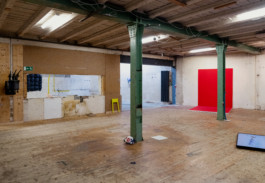
Finding Balance, 2022, Installation view
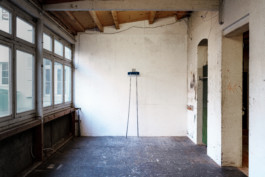
Zeno Germinale, high shelf, 2022, Schweissrohre (Polypropylen), Acrylglas, Hammerschlag, 36 x 210 x 28 cm
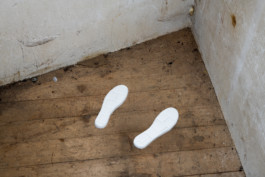
Finding Balance, 2022, Installation view
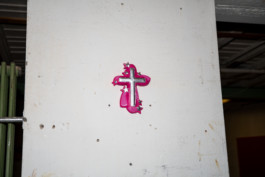
Florent Bonzon, I don’t want to live in a world without Glamour (#2), 2021, Harz, Sprühfarbe, Airbrush, 20 x 4 x 2 cm

Noah Ismael Wyss, Donna und Harry, 2022, Skulpturen, Silikon, Kunsthaar
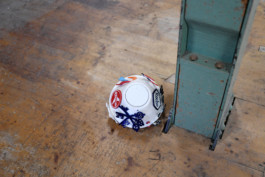
Teo Petruzzi, PROVIDEBIT OR CREDIT continued- 2 RICH 2 CURIOUS (remix), 2022, Performance (13.03, 16:00), mit Keramikobjekt von Lisa Lüdi
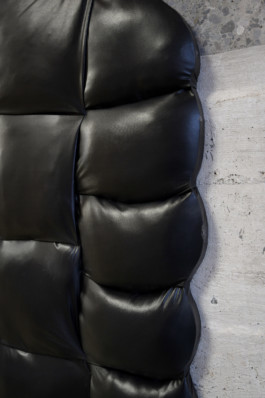
Felice Berny-Tarente, Puff Puff Man, 2021, Geformte, gepolsterte Leinwand, Watte, Stoffe, 150 x 120 cm
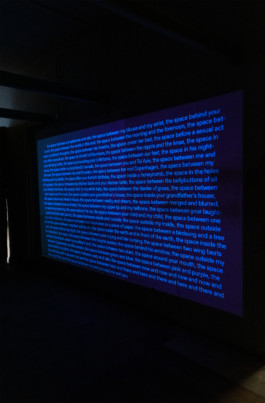
Nadine Kunz, YOU ARE HERE, 2021, Text Projektion 325 x 180 cm, Dauer variabel
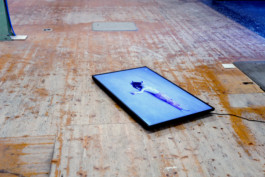
Sarafina McLeod, T TO THE SKY, LIGHT ELEVATION, 2021, Video Sequenz, 00:24 min
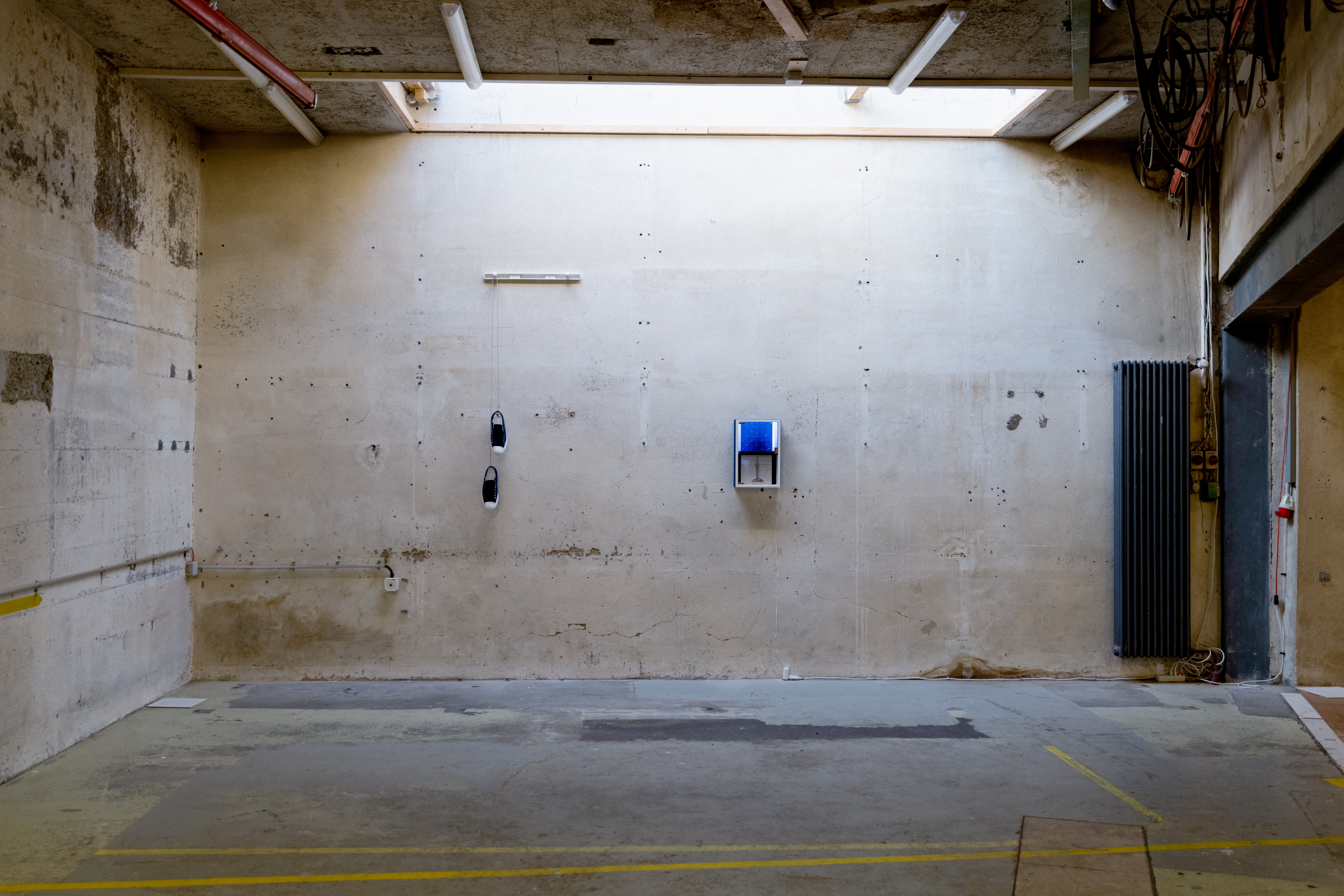
Alexeï Monney, My own private Bay, 2022, Mixed Media, 45 x 30 x 12 cm
FINDING BALANCE
04.03. - 13.03.2022
Florent Bonzon, Alexandra Galian, Zeno Germinale, Felice Berny-Tarente, Niels Hung, Alexeï Monney, Teo Petruzzi (with ceramics by Lisa Lüdi), Noah Ismael Wyss, Sarafina McLeod, Nadine Kunz
(DE) Das Gleichgewicht erfordert einen instabilen Boden. Um ein Gleichgewicht zu finden, muss zuvor ein Ungleichgewicht bestehen. Bei der Suche nach dem Gleichgewicht gehen wir Kompromisse ein. Work-Life-Balance. Wir setzen uns Ziele, wie wir das Unkontrollierbare kontrollieren können. Detox. Was ist, wenn wir das Gleichgewicht nicht finden, es vermissen? Es wiederentdecken. Selfcare. Was ist, wenn wir durch Zufall plötzlich das perfekte Gleichgewicht finden?
Die Arbeit von Felice Berny-Tarente beschäftigt sich mit der Balance von Binaritäten. Sie befasst sich mit dem Ausdruck von geschlechterspezifischen Normen und deren Aufbruch. Mit ihrer Arbeit «Puff Puff Man» entwirft Berny-Tarente eine Art muskulöse und trotzdem weiche Jacke, welche sowohl mit der Materialität und Oberfläche spielt, aber auch gesellschaftlich etablierte Bilder aufgreift. Ups, mal wieder 4 Stunden Bildschirmzeit diese Woche. «Donna und Harry» sind Objekte aus Silikon und Kunsthaar von Noah Ismael Wyss. Diese Arbeit erforscht nicht nur die physische Verschmelzung von Menschen und Technik, sondern wirft auch Fragen zur Beziehung von Mensch und Gerät auf. Abhängigkeiten werden sichtbar und die Vermenschlichung der immer intelligenter werdenden Supercomputer. Weil die drei «Tabourets» allein auf zwei Beinen nicht stehen können, lehnen sie verteilt im Raum an verschiedenen Wänden. Standhalten ist manchmal ein Balanceakt, Stabilität ein Luxusgut. Alexandra Galian versteht konstante Instabilität und einen bewegten Blick auf ihr tägliches Umfeld als wichtige Basis ihres meist malerischen Schaffens. Schlupflöcher zu finden, wenn man nicht in sich selbst hineinhören möchte, ist die einfachste Sache der Welt. Es gibt immer eine Ursache ausserhalb und es erfordert viel Mut, die eigenen Fehler zu erkennen und Verantwortung zu übernehmen. Und doch ist es der einzige Weg, um voranzukommen. Wenn das Leben eine Reise ist, dann ist es eine Reise, die nur bergauf geht. So beschreibt Alexei Monney seine Installation. Die grossformatigen Malereien «1+1=1» von Niels Hung nehmen Bezug auf die Räumlichkeiten der Schreinerei, enthalten in sich jedoch auch eigene Dimensionen. Sie können sowohl als reduzierte Darstellung eines Raums und einer Umgebung verstanden werden, wie auch als direkter Eingriff in den Raum. Horizontalen und Vertikalen sind ein zentrales Element in der Videoarbeit «T-Pose» von Sarafina McLeod. Die T-Pose ist ein Weg sich mit der Umwelt zu Verbinden. Es geht dabei um eine Aktivierung des Brustkorbbereichs und hat eine offene und energetische Wirkung.
Die Performance von Teo Petruzzi (die am Sonntag, 13.03. stattfindet) bezieht sich auf die Tradition des "Talerschwingens", die aus dem Appenzellerland stammende Tradition wird noch heute praktiziert. Die Verbindung zwischen Schweizer Tradition und Geld, die im Talerschwingen besteht, soll auf die Verflechtung von nationalistischen und kapitalistischen Schemen aufmerksam machen, die in der Schweiz besonders weit fortgeschritten ist.
I don’t want to live in a world without Glamour von Florent Bonzon lotet Grenzen zwischen Realität und Fiktion aus. Es stellt sich unweigerlich die Frage, wie sehr die Gesellschaft Kontrollverluste zu verzeichnen hat, wo wir Traditionen noch ernst nehmen und wo uns die digitale Welt längst in ihre glamourösen Welten verführt hat. Betrachtet man «High Shelf» von Zeno Germinale, schaut man hinauf. Es ist ein Zusammenspiel von allen Einzelteilen in Zenos Arbeit, die einen ausbalancierten Stand ermöglichen. Die Höhenunterschiede ergeben eine Spannung von Machtverhältnissen, welche auch auf unsere Gesellschaft appliziert werden könnten. Der Titel «high shelf» wirft die Frage des Zugriffs und der Zugänglichkeit auf bestehende Strukturen auf. Die Projektion «YOU ARE HERE» von Nadine Kunz thematisiert wie auch die Arbeit von Noah Ismael Wyss eine Verschmelzung bzw. einen Balanceakt zwischen Innen und Aussen. Textbasiert werden hier Zonen der Wahrnehmung erforscht und nach dem Ich, dem Du und dem Dazwischen gefragt. Ist der Prozess des Gleichgewichts etwas, das wir tun, oder etwas oder etwas, das einfach passiert?
(EN) Balancing requires an unstable ground. To find a balance implies a previous imbalance. In the process of seeking balance, we enter compromises. Work-life-balance. We set goals for ourselves, on how to control the uncontrollable. Detox. What if we don't find the balance, miss it? Rediscover it. Selfcare. What if we suddenly find the perfect balance by chance? This group exhibition shows through 10 positions of 10 different artists, a various range of perspectives on what the process of finding balance can possible be. Every artistic position deepen it self with the subject of balance in a own way. Trough the place and the setting the single works get in connection to eachother.
Hanging on the wall, Felice Berny-Tarente's work deals with the balance of binaries. It deals with the expression of gender norms and their disruption. With her work "Puff Puff Man," Felice designs a kind of muscular jacket that references both materiality and surface, but also addresses socially established images. Oops, another 4 hours of screen time this week. "Donna and Harry" are sculptures made of silicone and synthetic hair by Noah Ismael Wyss. This work not only explores the physical merging of humans and technology, but also raises questions about the relationship between humans and devices. Dependencies become visible and the humanization of the increasingly intelligent supercomputers. Because the three "Tabourets" cannot stand on two legs alone, they are distributed around the room leaning against various walls. Standing firm is sometimes a balancing act, stability a luxury item. Alex G understands constant instability and a moving view of her daily environment as an important basis of her mostly painterly work. Finding loopholes when you don't want to look inside yourself is the easiest thing in the world. There is always a cause outside and it takes a lot of courage to recognize your own mistakes and take responsibility. And yet it is the only way to move forward. If life is a journey, then it is a journey that only goes uphill. This is how Alexei Monney describes his installation. The large-format paintings «1+1=1» by Nils Hung refer to the premises of the carpenter's workshop, but also contain dimensions of their own within them. They can be understood both as a reduced representation of a space and an environment, as well as a direct intervention. Horizontals and verticals are also a central element in the video work "T-Pose" by Sarafina McLeod. The T-Pose is a way to connect with the environment. It is about activating the areas in the chest, which brings an open and energetic effect. The performance of Teo Petruzzi (which will take place on Sunday, 13.03.) refers to the tradition of «Talerschwingen», which originates from the Appenzellerland and is still practiced today. The connection between Swiss tradition and money that exists in Talerschwingen is meant to draw attention to the intertwining of nationalist and capitalist ideas that is particularly advanced in Switzerland.
Looking at "High Shelf" by Zeno Germinale, we look up. It is an interplay of all the individual parts in Zeno's work that allow for a balanced stand. The differences in height result in a tension of power relations that could also be applied to our society. The title «high shelf» raises the question of access and accessibility. I don't want to live in a world without Glamour by Florent Bonzon explores boundaries between reality and fiction. The question inevitably arises as to how much society has lost control, where we still take traditions seriously, and where the digital world has long since seduced us into its glamorous worlds. The projection «YOU ARE HERE» by Nadine Kunz, like the work by Noah Ismael Wyss, addresses a fusion or balancing act between inside and outside. Text-based, zones of perception are explored here and questions are asked about the I, the you and the in-between. Is the process of balance something we choose to do, or something, or something that just happens?

Alexeï Monney, My own private Bay, 2022, Mixed Media, 45 x 30 x 12 cm

Finding Balance, 2022, Installation view

Florent Bonzon, I don’t want to live in a world without Glamour (#2), 2021, Harz, Sprühfarbe, Airbrush, 20 x 4 x 2 cm

Zeno Germinale, high shelf, 2022, Schweissrohre (Polypropylen), Acrylglas, Hammerschlag, 36 x 210 x 28 cm

Finding Balance, 2022, Installation view

Noah Ismael Wyss, Donna und Harry, 2022, Skulpturen, Silikon, Kunsthaar

Teo Petruzzi, PROVIDEBIT OR CREDIT continued- 2 RICH 2 CURIOUS (remix), 2022, Performance (13.03, 16:00), mit Keramikobjekt von Lisa Lüdi

Felice Berny-Tarente, Puff Puff Man, 2021, Geformte, gepolsterte Leinwand, Watte, Stoffe, 150 x 120 cm

Nadine Kunz, YOU ARE HERE, 2021, Text Projektion 325 x 180 cm, Dauer variabel

Sarafina McLeod, T TO THE SKY, LIGHT ELEVATION, 2021, Video Sequenz, 00:24 min